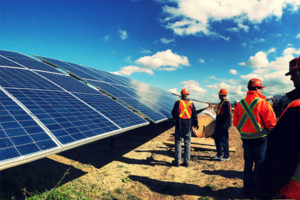Washington — North American solar power purchase agreement (PPA) offer prices have leveled off in Q2 2023, as per a new report from LevelTen Energy, the operator of the world’s largest PPA marketplace.
This marked a noteworthy 1% decrease from Q1 numbers, the first drop since Q1 2020, though there was a 25% increase year over year. In contrast, P25 wind index saw an upswing, increasing 13% from Q1 and 30% annually.
“The decrease of 1% is a small, yet promising indication that market conditions for solar PPAs are stabilizing,” said Gia Clark, senior director of strategic accounts at LevelTen Energy.
Challenges like inflation, supply chain issues, rising interest rates, and regulatory uncertainty have beset solar developers in recent years. However, Clark said that progress has been made in tackling these issues. The Inflation Reduction Act, now nearly a year old, allows developers to incorporate its benefits into business strategies, providing some relief from price increases.
Another positive trend is the increased mobility in the solar supply chain. Q1 2023 saw 12 gigawatts (GW) of PV modules imported into the U.S., contributing to 6.1 GW of solar capacity additions. In comparison, a total of 29 GW was imported during the entire year of 2022.
However, wind PPA prices have surged due to a low supply in the market. “Wind projects typically have higher capacities and are less flexible in siting conditions than solar projects, making it more challenging to secure land control,” Clark explained. Lengthier interconnection studies and rising interconnection costs have also contributed to the price hike.

A Corporate Power Purchase Agreement (PPA) is a long-term contract under which a business agrees to purchase electricity directly from an energy generator. This differs from the traditional approach of simply buying electricity from licensed electricity suppliers, often known as utility PPAs. (DLA Piper)
The study found that the duration from connection request to commercial operation has doubled from less than two years for projects built between 2000 and 2007 to nearly four years for those built between 2018 and 2022. Clark emphasized that the delay leads to increased costs, resulting in higher PPA prices.
“Fewer wind projects are entering the market compared to solar due to permitting and interconnection issues,” Clark said. However, she noted that offshore availability, owing to recent offshore permitting reforms, and potential development of projects co-located with solar could increase the supply. Despite the limited options, demand for wind has held steady, particularly from buyers looking to diversify their portfolio and those targeting clean electricity generation.
The first half of 2023 saw LevelTen Energy track 11.9 gigawatts of clean energy capacity contracted via PPAs in North America, putting 2023 on course to surpass the 22.5 gigawatts signed in 2022.
“Both corporations and retail electricity providers are increasingly demanding clean energy,” Clark said. “However, it will be more challenging to find clean energy projects that have obtained interconnection approval. Corporations need to act now to secure PPAs that will help them reach their emissions reduction targets.”
The report also showed that PPA prices varied across Independent System Operator (ISO) markets, with prices being affected by region-specific regulations. While most markets saw solar PPA prices remain flat, ERCOT experienced a 14% rise due to legislative uncertainty in Texas.
As for wind availability, PJM saw a significant decrease due to local opposition, permitting hurdles, and lengthy interconnection queue, causing some developers to shift towards solar development.
“Price stabilization in the market after years of increasing prices makes now a good time for buyers to procure,” Clark suggested. She underscored that a swift approach would be beneficial in the current competitive environment.
LevelTen recently launched PPA Auctions to allow buyers to quickly secure PPAs with mature projects through an efficient auction process, mitigating the risk of project delays and continued price fluctuations.









Comments